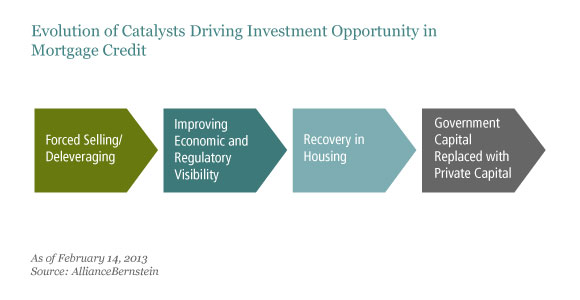Is the mortgage trade over? No, and in some ways, it’s just beginning.
The annual returns above 20% we were seeing as markets recovered from the financial crisis are largely behind us. However, a carefully selected and managed portfolio of legacy mortgage credit—specifically nonagency residential mortgage-backed securities (RMBS) and commercial mortgage-backed securities (CMBS)—continues to look compelling, in our view, both on an absolute basis and relative to other fixed-income alternatives.
Legacy mortgage credit offers a combination of attractive attributes, including solid loss-adjusted yields; low historical correlations to other fixed-income securities and to equities; good downside protection; upside potential in a continued housing recovery driven by lower default rates; lower loss severities; and greater levels of voluntary prepayments, as fewer borrowers will be underwater.
We believe that many of these positives are not priced into valuations. While results will be very bond specific, there exists the potential for outsize returns among these credits.
But that’s not the only potential we see.
More Opportunities Could Arise as Government’s Role Shifts
A stronger and more stable footing for the housing market will enable the federal government to begin to slowly decrease its involvement in the market.
Currently, the government supports—either explicitly or implicitly—roughly 90% of new mortgage originations. This compares to an average of 63% of new originations pre-crisis.
As the government’s market share decreases toward historical levels, we expect private capital to fill the hole, creating attractive investment opportunities in newly issued mortgage credit, both nonagency securitizations and government-sponsored enterprise (GSE) risk-sharing securities.
We believe that the government’s role in housing finance—while necessary—should be limited primarily to ensuring market stability and promoting liquidity through the provision of catastrophic loss insurance behind meaningful private capital.
As we have discussed in the past, we see two potential market-based solutions that the GSEs could use to share credit risk with private investors. While the ultimate structure of the US mortgage market is far from certain, one thing we can be sure of is that, given its size of $10 trillion, even a small change in the government’s share of the market will create significant investment opportunities
.
The views expressed herein do not constitute research, investment advice or trade recommendations and do not necessarily represent the views of all AllianceBernstein portfolio-management teams.